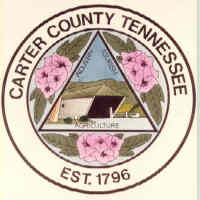This Web site aims to aid researchers in locating family and local history resources and information.
About Carter County
Location
Located in the northeastern section of Tennessee, Carter County is surrounded by the natural beauty of the Cherokee National Forest, Roan Mountain State Park, the Appalachian Trail, the Overmountain Victory Trail, and Watauga Lake. Local tourism promoters describe Carter County as “Tennessee’s Mountain Playground.”
The county is bounded on the north by Sullivan County, on the east by Johnson County, on the south by Unicoi County and the North Carolina state line, and on the west by Washington County.
North Carolina border counties are Ashe, Avery, Mitchell, and Watauga.
Formation of Carter County
Carter County was formed from Washington County, North Carolina, on April 9, 1795. The county seat is Elizabethton.
In January, 1796, delegates met at Knoxville for a constitutional convention; on June 1, 1796, President George Washington signed the bill admitting Tennessee to the Union as the sixteenth state. Carter County joined the new state.
Carter County was named for Landon Carter. Elizabethton was named for Elizabeth McLin Carter, wife of Landon Carter.
Divisions of Carter County
Carter County is the parent county of two other Tennessee counties. Johnson County was created from the northeastern section in 1836. Unicoi County was created from the southern area of Carter County and southeastern area of Washington County in 1875.
The Official Seal of Carter County Government
 Designed in May, 1974, by Denton C. Sansom, Director of Elizabethton-Carter County Civil Defense, the official seal was adopted by a County Court resolution. The center of the seal depicts the west end of the historic Doe River covered bridge, enclosed in a triangle with the words: Agriculture, Industry and Tourism. The three sides are rhododendron representing the rhododendron on Roan Mountain.
Designed in May, 1974, by Denton C. Sansom, Director of Elizabethton-Carter County Civil Defense, the official seal was adopted by a County Court resolution. The center of the seal depicts the west end of the historic Doe River covered bridge, enclosed in a triangle with the words: Agriculture, Industry and Tourism. The three sides are rhododendron representing the rhododendron on Roan Mountain.
Early History of Carter County
For the pre-statehood history of Carter County, visit the Washington County TNGenWeb page.
All of East Tennessee was originally part of the “Washington District” of North Carolina, organized in 1775, and designated Washington County, North Carolina, in 1776. When the State of Franklin/Frankland existed (1784-1788), the area of now-Carter County was included in Washington County in the disputed state. Washington (including modern Carter) County was part of the Territory South of the River Ohio, also known as the “Southwest Territory” in historical records. When Tennessee was established on June 1, 1796, Washington County
Present-day Carter County includes historic locations that were crucial to Tennessee’s settlement.
In 1772, the Watauga Association compact enacted the first majority-rule system of American democracy, The Articles of the Watauga Association established an independent government, based on democracy as we know it today, four years before the American Declaration of Independence was written by Thomas Jefferson. Four years later, many signers of the Articles petitioned the state of North Carolina to be part of its state government.
The Treaty of Sycamore Shoals was signed on March 17, 1775. The Transylvania Company, led by Richard Henderson, was involved in the largest private real estate transaction in United States’ history. For the price of 2,000 pounds sterling and 8,000 pounds in goods, he purchased 20 million acres of land from the Cherokee Indians.
Fort Watauga was pivotal in colonists’ success during the Revolutionary War. The fort was used as a base to defend the frontier against the Indians and the British. In July, 1776, settlers at the fort withstood two weeks’ siege by the Cherokees, led by Old Abrams.
In late September, 1780, the Overmountain Men mustered at Sycamore Shoals for their march to Kings Mountain, SC, to engage British Colonel Ferguson, who had threatened to march over the mountains and lay waste to their land with “fire and sword.” Ferguson was killed, and most of his troops were captured. This battle was the turning point of the Revolutionary War in the South. It saved the Patriot cause, which had suffered many military defeats in this region, and set off events that led to Cornwallis’ surrender at Yorktown the next year.
Browse the Historic Sites section of this site for more information about each event.
